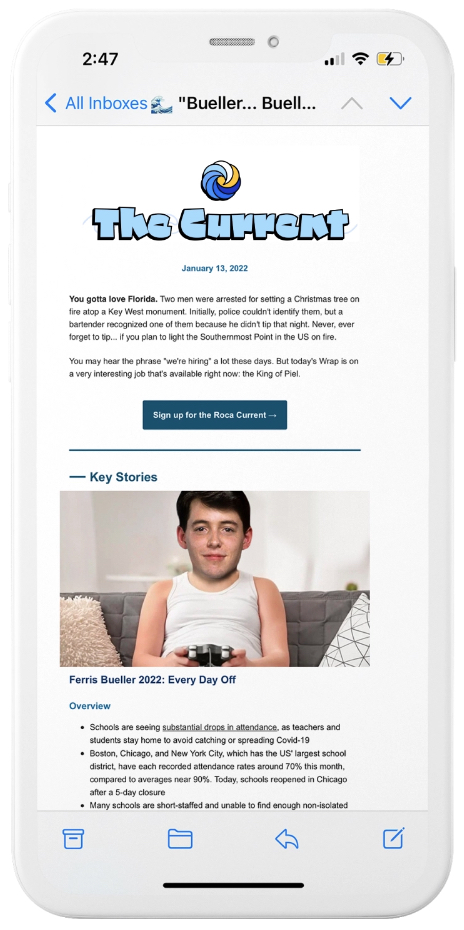|
Getting your Trinity Audio player ready...
|
RocaNews began after its founders struggled with news overwhelm and avoidance at the beginning of the pandemic. Now, with over a million Instagram followers and 175k newsletter subscribers, the start-up is turning its attention to its own social news app.
Confidence in newspapers and television news is at an all-time low, according to the latest annual Gallup survey of trust in U.S. institutions. This is backed up by the findings from the latest Reuters Digital New Report, which showed that despite a welcome bump during Covid, just 42% of those surveyed trust news most of the time. News avoidance is on the rise, with 38% of people globally actively choosing not to read or watch the news.
A relentless bad news cycle and news fatigue from over two years of extreme Covid coverage are often cited, but it points to a wider trend. “Many respondents [said] news has a negative effect on their mood,” said one of the report’s authors Nic Newman.
In Washington, Max Frost and Max Towey found themselves in early 2020 – like many others – completely overtaken by the volume of negative news.
“Our lives were the news,” Max Towey told the Media Voices Podcast. “Everybody was inundated with news all day. And at that point, it felt like the problems we and our peers had felt with the news media reached a fever pitch level in terms of the alarmism and the partisanship.”
The two spent four months thinking about what an alternative news site would look like, one which would appeal to them and their friends. Along with Billy Carney, they launched RocaNews in August 2020.
From an afterthought to a core engagement platform
Initially, RocaNews started as a website. Social media, and Instagram in particular, was an afterthought. “One of our realisations in December 2020 was, wait a second, why are we doing the website thing and Twitter?” Towey explained. “Our friends are all on Instagram. That’s where all the millennial and upper Gen Z generations spend most of their time. Shouldn’t there be good news on Instagram?”
After some initial experimenting, RocaNews developed a formula for posting on Instagram: four stories a day, plus a deep dive on a random subject. The meme-style slides are packed with pop-culture references and humour, and yet manage to remain neutral, only reporting bullet point-style facts.

As the follow count began to snowball, the team realised they were on to something. “Once we developed this formula, it caught on, so we were very lucky that people liked it,” said Towey. “[Our Instagram following] ended up going from 10,000 to 100,000. And then by last fall, a million.”
It won’t be a surprise to learn that RocaNews is also doing well on TikTok. Despite only launching at the end of April, the publisher already has over 100,000 followers. But rather than replicate the Instagram content, they are trying something different.
“We want TikTok to be more about our brand and our personalities, the office talk, doing street interviews… the idea is to make it fun,” Towey explained. “When we think about building the company generally, we don’t want to have this stiff, unrelatable demeanour. Instead we want to make the news enjoyable and [use TikTok] to sell the brand.”
“We ask, is this something that feels personal to me, something we really, really care about? Developing entertaining content is the most important thing – you have to adapt to each platform.”
Old-school email
RocaNews hasn’t just seen success on Instagram. Its daily newsletter, The Roca Current, has over 175k subscribers and has been a key factor in the brand’s growth in recent months.
Given RocaNews’ approach is aimed at younger people, email is a curious choice of platform. In the US, 15% of over 55’s use email as their main news source, but just 3% of 18-24’s do the same. Although Instagram has the largest audience for RocaNews, they see the email as a way to encourage readers to go deeper.

“We’ve been surprised at how many under 35’s have come to email,” Towey explained. “We didn’t want to place a lot of eggs in that basket early. But it turns out that, especially for news-interested young people who really want to go deeper, there’s an appetite for that.”
Towey speculated that the reason many young people don’t get news via email is that a lot of newsletters are out of touch and impersonal. They try to approach it like a friend updating you on the news; telling interesting stories and building a relationship.
“For TheSkimm, early on their founders Danielle and Carly were advised against the newsletter model, because who reads newsletters? Their point was, who reads existing newsletters? Nobody. But we can make one that they do read.”
Community
Towey credits some of RocaNews’ success on Instagram to their focus on community. “A lot of people have the impression that there’s a glass panel that separates news companies or publishers and the audience,” he said. “When you read a news piece, you can comment on the website or dig up the author’s email and try to send a message, but it feels so impersonal.”
“For us, we’re always responding to DMs. Always responding to emails. Always engaging in the comment section. So we’ve developed a community of sorts, and that’s our favourite part.”
That approach is manageable with a few thousand followers. But how does that scale up with over a million followers, plus email newsletter subscribers? Towey estimated that the team spends a combined 12 hours a day responding to DMs and emails, and getting to know the readers. “It’s a lot of work, but we think it’s a worthy investment,” he emphasised.
Building a news app for young people
It’s all very well to have built such an enormous following on Instagram, but Towey is well aware that there are downsides to relying on the platform. The focus for RocaNews now is building their own app.
“We think there’s real value in developing a platform that allows you to control the news experience,” he said, noting that the endless scrolling of social media is unnecessary and harmful. “We envision a platform that tells you at the end of the day, you’re done. Congratulations! You’e got the news you needed to know. Go outside and enjoy the day.”
It’s an approach that a number of mainstream publishers are seeing success with. The Financial Times launched FT Edit in April. “The purpose of FT Edit is to provide an alternative to endless scrolling, allowing readers time to digest eight important stories selected for them each day,” they noted. “It will launch with the strapline: time well read.” Danish publisher Zetland gives their subscribers just two stories each day, calling it a “finishable feature”.
Although RocaNews’ app is in the early stages, Towey is keen to explore gamification tools in order to make it fun whilst also building a (finishable) daily habit. He cited Duolingo as an inspiration, with users incentivised to come back for a few minutes each day in order to continue streaks and unlock rewards.
Lowering the temperature
News that appeals to young people doesn’t mean dumbed-down news or avoiding difficult issues. RocaNews’ approach is to balance out the firehose of crisis-driven headlines with stories about breakthroughs in medicine, science, culture, and other positive stories.
“We will not shy away from important conversations and coverage on the world’s most important stories,” he emphasised. “Terrible things happen all the time. Our job is to not sugarcoat them, or put a positive spin. Tragedy exists, it’s terrible, and it’s our duty to cover it. And we do that with facts.”
“It’s the obsession of the darkness and of the world that we believe is not a reflection of the world. So our job is to hold the reflection, it’s not to make the world seem like one giant candy shop, because it isn’t, but instead to cover tragedy, barely and fact-based and then also try to balance it out with some interesting stories. And cover things that give us hope.”
When it comes to hot-topic issues, taking a neutral approach is vital for building trust with RocaNews’ audience. They are careful how much attention they develop to politics in particular, as the discourse around political issues is especially intense in the US.
“We believe that there’s an unhealthy obsession with politics,” Towey noted. “Of course, it’s relevant to people’s lives. But that doesn’t mean it deserves 24/7 attention. It doesn’t mean you should build your identity around it.”
“The media has been very irresponsible and pitting groups against each other and feeding this partisanship in vilifying groups and playing to their base… We believe the only way it can come back together is by lowering the temperature because the 24/7 food fight culture just can’t work.”
This approach is evident in recent examples, such as the FBI’s raid of Trump’s Mar-a-Lago residence. RocaNews reports on it, but with four factual bullet points, which (hopefully) people can agree on regardless of their political leanings.

Establishing revenue streams
RocaNews went through a funding round in January 2022, raising $4.4 million which will go towards hiring more writers, and launching the news app. Towey is adamant that the news Roca produces will remain free and independent. So in the near term, they are reliant on advertising.
They are also planning to expand their ecommerce and merchandise offerings. An early store front offers a range of meme-based t-shirts poking fun at billionaires like Bezos and Musk, alongside some RocaNews-branded clothing.
Building trust
RocaNews is the type of outlet that many news professionals look down on as not being ‘proper’ news. But the news doesn’t have to be crisis-driven and ever so serious all of the time. Although the publisher for now relies almost entirely on the reporting of other newspapers, its approach to topics is clearly working.
We don’t need to all turn to memes and bullet-pointed slideshows to win over younger audiences. The way RocaNews takes the heat out of divisive topics in order to present just the facts is building trust with an audience that is weary of the mainstream media’s approach.
Max Towey spoke to the Media Voices Podcast about RocaNews and building a community around news that lowers the blood pressure. Listen here: the interview with Max starts at 17:30.


